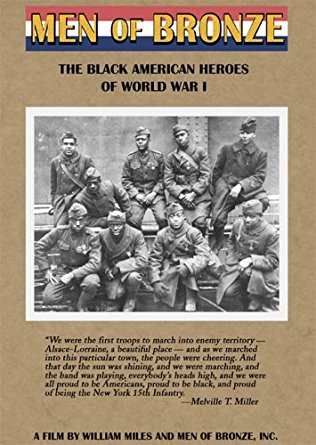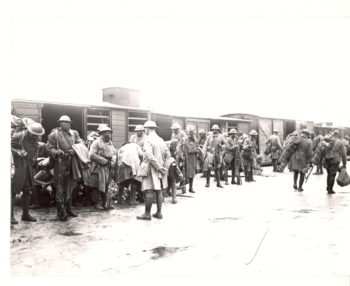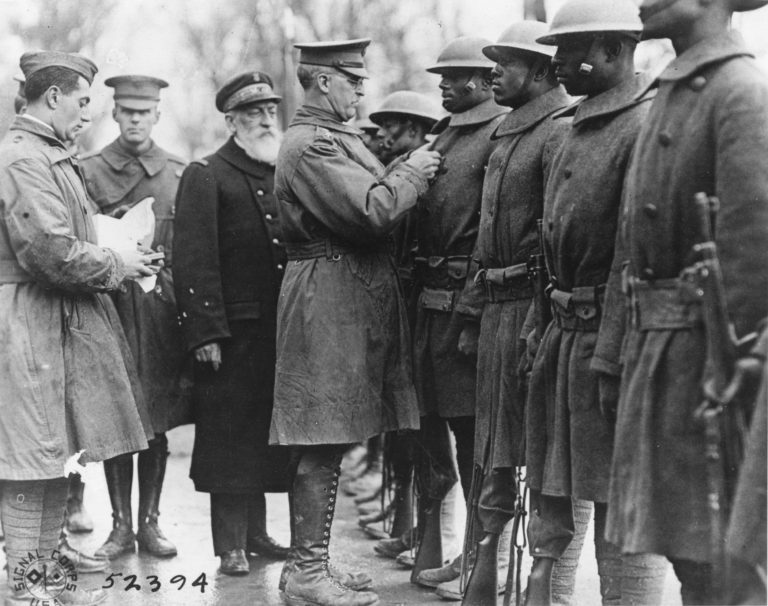
Documenting WWI: The Harlem Hellfighters in Men of Bronze

As we continue to highlight collections related to America’s entry into WWI a century ago, we cannot neglect the seldom-told story of the African American regiment that fought on the front lines in France during the war. Known officially as the 369th combat regiment, these men from New York were given the nicknames Harlem Hellfighters and Black Rattlers, but the French troops they served with called them “Men of Bronze.”
It is this last name that serves as the title of filmmaker William Miles’ 1977 documentary on these brave men, several of whom are interviewed in the film itself. Washington University Libraries’ Film and Media Archive houses a large collection of material that Miles created or gathered during the production of Men of Bronze, including interviews, correspondence, photographs, and the film itself.
William Miles: Documenting the Stories of African Americans
William Miles was born in Harlem, New York in 1931. As a young boy, he was fascinated by film, but he did not see any representations of his community on the big screen. He became a documentary filmmaker to highlight the little-known stories of African American achievements in the military, the arts, sports, and in aerospace and exploration, and to document the rich history of Harlem where he lived. Men of Bronze was his first documentary, followed by I Remember Harlem and Liberators: Fighting on Two Fronts in WWII, the latter of which was nominated for an Oscar.
The Story of the Harlem Hellfighters
In Miles’ documentary, WWI veterans tell the story of the creation of the first African American regiment to serve with American forces during WWI. Because of segregation, there was no provision for African Americans to join the New York National Guard until 1913 when a bill was passed to create an African American regiment in the state. However, the bill was ignored until 1916, when William Hayward was assigned to raise a regiment from the neighborhoods of San Juan Hill, the Williamsburg section of Brooklyn, and Harlem. This 15th Infantry Regiment of the New York National Guard would eventually become the 369th Combat Regiment of the United States.

Recruiting was slow at first, but gained some momentum when James Reese Europe, a popular composer and conductor, joined the regiment and recruited others. Under his leadership, the 369th division’s regimental band would later become famous as it played throughout France, introducing jazz to a new audience.
Initially, the 15th Regiment was underfunded and practiced combat with wooden guns in various locations throughout Harlem. By July of 1917, the regiment was called to active duty with the 27th division of the New York National Guard. They were originally sent to Spartanburg, South Carolina for training, where they were immediately faced with hostility and discrimination from the white soldiers stationed there. Miles’ documentary tells a story of an Alabama regiment planning an attack against the 15th Regiment while they were still unarmed. The conflict was only avoided when the Hellfighters were given arms at the last minute, which managed to persuade the Alabama regiment that an attack would be detrimental to both groups.
When the regiment was finally sent to France, they received a similarly hostile reception from white United States marines who were already there. Because the United States refused to mix black and white troops, the Hellfighters served as laborers for their first three months abroad, even though they had been designated as a combat regiment.
The Hellfighters were eventually loaned to the French army, which was on the verge of collapse and desperately needed the support. They turned in their uniforms and were issued French gear and assigned partners in the French army to help them become accustomed to warfare on the front lines. For the remainder of the war, the regiment spent more time in the front-line trenches than any other American unit. They became a part of the famous Meuse-Argonne Offensive near the Champagne region of France, where they fought bravely and suffered severe casualties. They were also the first Allied unit to advance to the Rhine. At the end of the war, the 369th received both American and French decorations and returned to the States with great fanfare.

The Harlem Hellfighters Today
Although the story of the Harlem Hellfighters has often been overlooked, it is currently experiencing a long-overdue revival in popular culture. World War Z author Max Brooks released a fictionalized account of the regiment in his 2014 comic, The Harlem Hellfighters, which is currently being made into a television series by Will Smith’s production company, Overbrook Entertainment.
More About the Collection

Washington University Libraries’ Film and Media Archive has a large collection of Miles’ works, interviews, stock footage, manuscripts, correspondence, and photographs. Washington University in St. Louis’ Men of Bronze collection is still in the process of being cataloged, but you can get a sense of the extent of the materials Special Collections holds, including interviews, photos, and correspondence, by looking at its current holdings record. If you have any questions about the collection, please contact the Film and Media Library.
Sources:
- Men of Bronze. Directed by William Miles and narrated by Adolph Caesar. 1977.
- Yockelson, Mitch. “Harlem Hellfighters” Encyclopedia of war and American society. Vol. 1. Ed. Peter Karsten. Sage, 2005.
